This year, Tulasankramana festival in Kodagu is likely to see fewer pilgrims due to the COVID-19 restrictions.
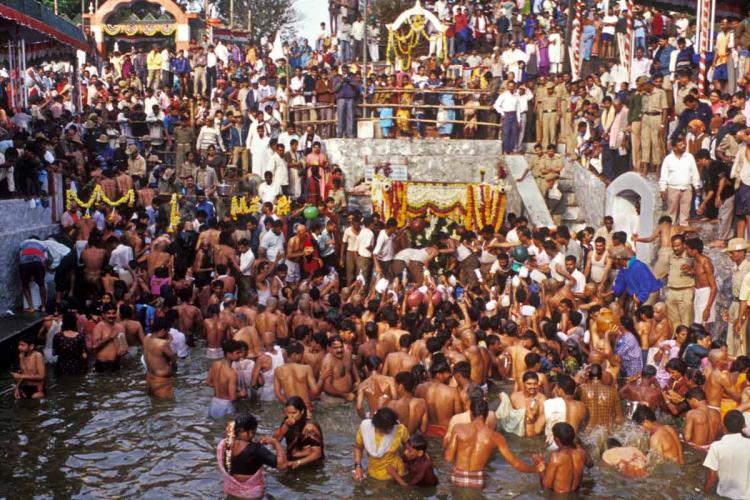
Come October and goddess Cauvery will appear in the form of a sudden upsurge of water in a small tank to give darshan to pilgrims who come to seek her blessings, bathe in her waters, and carry back bottles of holy water from Talacauvery, the source of the river in Kodagu district of Karnataka. Unlike the usual practice, this year, scores of devotees from Kodagu and places adjoining the state will not be able to throng the verdant slopes of Brahmagiri hills to participate in the annual celebrations of Tulasankramana. Due to COVID-19, there will be restricted entry of devotees besides the mandatory masks, physical distancing and COVID-19 test negative certificate. The district administration will have checkpoints 8 kilometres from the venue, where devotees would be screened for temperature and other symptoms.
It is believed that every year, on October 17, the river goddess renews herself with a fresh thirtha, signified by a gurgling sound in the brahmakundike, in the tiny two-and-a half-feet square of an enclosed area in the surrounding pool and then fills up the bigger tank or the pushkarni at the shrine. Known as theerthoudbhava (when water gushes from the spring), this event takes place with clock-like precision at a predetermined time, predicted precisely each year by priests on the basis of planetary configurations and astrological calculations. This year, theerthoudbhava (spouting of the holy spring) is scheduled at 07.03 am on October 17. Kodavas, an ethno-lingual tribe from Kodagu, believe that at that particular moment, all the wells in Coorg come to life.
How Tulasankramana is celebrated
Tulasankramana festival is celebrated with much festivity and fervour all over Kodagu. A puja is offered to the river goddess at the tank as a prelude to the ushering in of the Cauvery. Coconuts adorned with jewels and flowers and small bowls of kumkum (vermillion) floating down the tank in memory of Cauvery, the presiding deity of the landscape, is an unforgettable sight.
Besides this small tank, there is a large tank where the devotees take their holy dip amid the chanting of Sanskrit shlokas eulogising Cauvery. After the puja, they wade in knee-deep water for a grab of the tirtha (sacred water) – in cans and bottles. The initial spurt of water is strong and is said to possess curative powers. It is believed that it bequeaths life to a dying man and helps him attain moksha (emancipation). This sacred water forms part and parcel of every household in Coorg. After the puja, devotees visit the smaller shrines dedicated to Ishwara and Ganapathy, dotting the expanse of the hill above the pool.
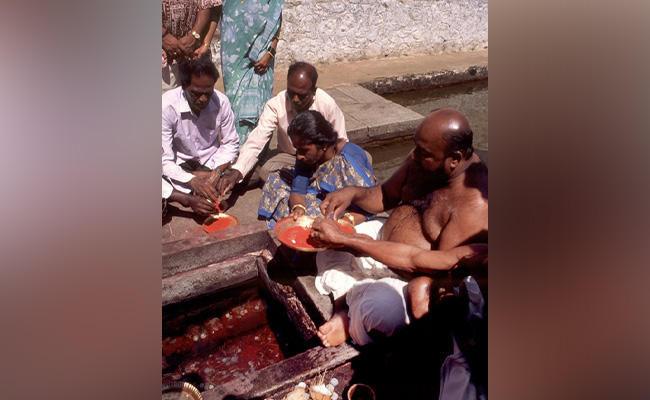
Tulasankramana is a time for rejoicing for the Kodavas. Split bamboo is planted in cultivated lands and paddy fields, decorated by a garland of specified forest creeper to signify that they are devotees of Cauvery. Homes are all spruced up and sprinkled with holy water before sunrise, as the goddess is believed to visit every home during this period. Vegetable carvings of goddess Cauvery are decked with flowers and installed in each home for a period of three days. A small lamp is lit by its side and family prays with another offering of rice. A tray containing some rice, betel leaves and nuts is placed near it. The Kodavas venerate and worship river Cauvery and it continues to be a strong religious binding force.
The legends behind Tulasankramana
A number of legends are woven around the goddess. According to a popular legend, she was the daughter of Brahma, the god of creation, but was brought up by the great saint Kavera. Agasthya, the learned sage, was enamoured by her charm when he came to visit her foster father. He proposed to her and she agreed, on one condition. She pledged that if he were ever unfaithful to her, she would go away, become a river and serve her people. Once he broke the promise and she transformed into a river. Agasthya tried to stall her, grabbed her by the sari, pushing back the pleats in the process. (No wonder the women of Coorg wear the sari with pleats folded at the back!) She rushed away and disappeared underground for a while, surging again as the mighty river, gushing down a rocky mountainside.
At this site, a small shrine was built signifying the birth of the river. When the Kodavas, her devotees pleaded with her to remain her protective goddess, she assured them that she would continue to take care of them and would visit her birthplace, Talacauvery and regain her freshness every year during ‘Tulasankramana.’ The Cauvery is a venerable river, considered as one of the seven sacred ones — Sapta Sindhu — by the Hindus.
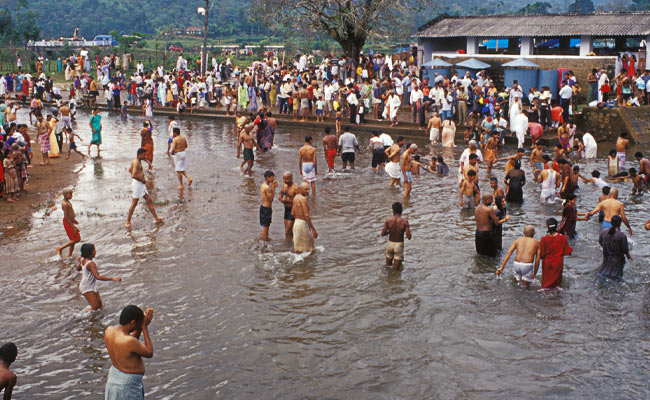
From Talacauvery, the river mysteriously disappears for a distance of seven kilometres, to re-emerge at Bhagamandala, a customary stop for all pilgrims proceeding to Talacauvery. To the people of Kodagu, the Talavauvery pilgrimage is not complete without a holy dip at the Triveni Sangama, the confluence where Cauvery meets river Kannike and the legendary underground river Sujyothi.
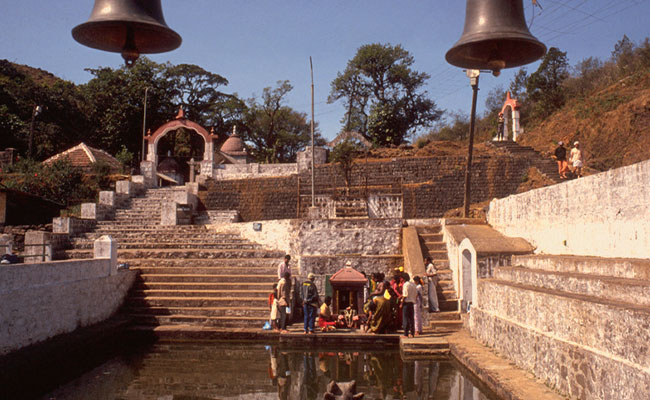
People bathe at this stunning spot and the Kodavas offer pindadana — an offering to ancestors after tonsuring their heads. A short distance away from the confluence is the cluster of three impressive temples, the main temple being that of the Kerala-style Bhagandeswara temple. Located in a central courtyard, the temples flaunt elegant, exquisitely carved pillars and wooden ceilings. There are also sloping red painted roofs supported by gilded snake-heads and a variety of musical instruments strung from the rafters around the courtyard.
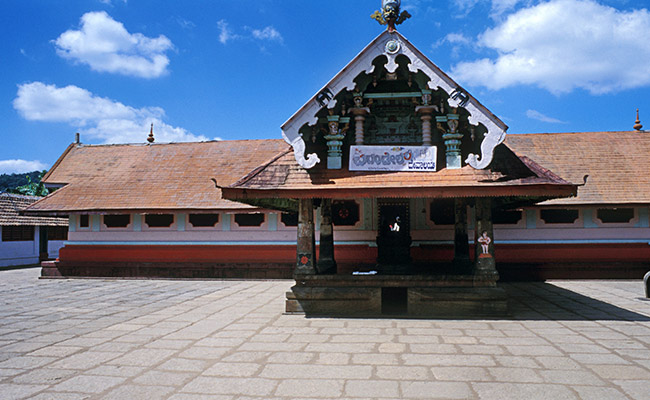
Cauvery: Lifeline for Karnataka, Tamil Nadu
It is believed that the munificence of river Cauvery is venerated and revered as a mother, a life-giving force, symbolising the largesse and abundance of woman, of her spirit of grieving and nurturing, of struggle and survival. Right from its place of origin at the magnificent foothills of the Brahmagiri Hills in Kodagu, till it plunges into the Bay of Bengal at Poompuhar in Tamil Nadu, snaking its way for 765 km, it has no parallel. It serves as the lifeline of the states of Tamil Nadu and Karnataka. The Cauvery has remained a strong religious binding force and provides water for drinking, irrigation and hydroelectricity along its course. The presence of the river Cauvery is as endemic to Coorg as is coffee. Without it, life in the region would be difficult if not impossible.
Susheela Nair is an independent food, travel and lifestyle writer and a photographer.
source: http://www.thenewsminute.com / The News Minute / Home> Features> Festival / October 16th, 2020

